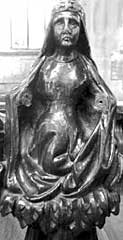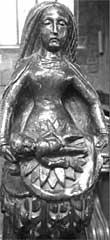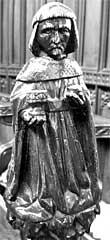The Poppy-head Carvings at Rotherham Minster
By John Wilson who also provided the photographs.
Many modern churches have carvings, sometimes very elaborate, on the finials of benches, often in choir stalls. These carvings are frequently termed ‘poppy-heads’. One of the most common designs is the fleur-de-lys.
Rotherham minster [visited recently by Thoroton members – see report elsewhere] has a most unusual set of poppy-heads, which date from c1480. They represent the story of the birth of Jesus. First we see the Virgin Mary receiving the Archangel Gabriel at the annunciation.
We then see Mary with Jesus on her knee. Opposite her is a figure which some have regarded as Joseph. An alternative theory is that he is Simeon, at the presentation in the Temple, where he says what we now call the Nunc Dimittis. This gains credence because, although we know from the Bible that Joseph was older than Mary, the figure is that of a very old man, and Mary is displaying Jesus rather than cuddling him.
 |
 |
 |
 |
| The Virgin Mary | Archangel Gabriel | Mary with Jesus on her knee | Joseph or Simeon |
Near to Mary and Joseph/Simeon are three figures representing the Magi bringing their gifts to Jesus. They are arranged so that they appear to be processing around the top of the Chancel.
The last figure in the set is that of a boy or young man. He appears to be carrying a palm branch and is facing west, with his back to the altar. It is thought that he represents the Holy Innocents who were slaughtered on the orders of King Herod. He is facing west to indicate that his young life is near its end. Just over his right shoulder can be seen one of the Magi, turning to the right as if in a procession towards Jesus.
 |
 |
 |
 |
| The Magi | Boy/young man | ||
These poppy-heads raise some interesting questions. Firstly, is this set unique or does it occur in other churches? I have not seen anything like it before. Secondly, has anyone made a study of the poppy-head carvings in Nottinghamshire churches? If not, this might make an interesting Thoroton Society research project.
< Previous